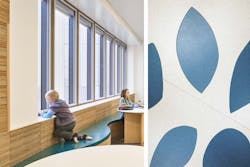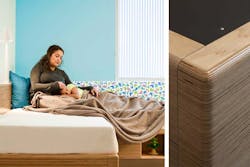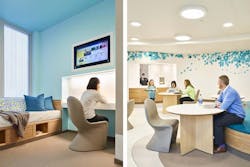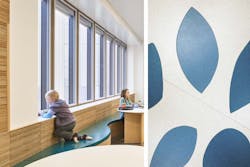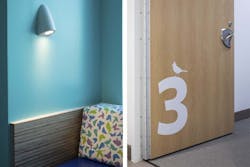A critical challenge in behavioral health design is the need to balance aesthetics, dignity and comfort with safety. This is especially true when it comes to the interior. Furniture and fixtures designed for these environments have historically exuded an institutional feel which undermines the familiar, calm, healing environment that research suggests is required to promote good outcomes. This challenge is particularly acute on projects which serve diverse patient populations with a range of needs—such as the Big Lots Behavioral Health Pavilion at Nationwide Children’s Hospital, the largest pediatric behavioral center in the nation. However, by building on evidence-based research and design R&D, and considering not just how furniture looks and functions but how it can be adapted and maintained over time, behavioral health facilities can reinforce both dignity and healing. Below are four key elements to consider when devising a furniture strategy for behavioral healthcare facilities, drawn from our research and experience designing the Behavioral Health Pavilion in collaboration with architecture+.
If It Doesn’t Exist, Design It
In researching furniture options, the Behavioral Health Pavilion team found that existing products tended to emphasize durability at the expense of comfort. To address the specific needs of a patient population which included both teenagers and younger children, more reassuring, comfortable furniture was needed, which at times required a custom-built solution. For example, the patient rooms, which are designed to feel more like dorms or living rooms, required a sleeping and seating platform which provided space for family and was made of natural, durable, economical materials.
Unable to find a commercially available product which met these requirements, the team created a L-shaped built-in bed with space for storage and for parents to sit, lie down and spend time with patients during their recovery process. Built by local millworkers, the custom element uses stacked plywood as a more economical wood option, which maintains a durable yet natural feel that takes on an appealing patina as wear and tear accumulates. Mockups—which served as a real-world example of the building’s aspirations for a more comfortable, familiar type of care environment—were used extensively to work out the design details, and as a tool to help raise mental health awareness and secure sponsorship through touring state legislators, community leaders and donors.
Ensure Adaptability
While furniture in behavioral health settings must be safe, durable and attractive, it should also adapt to different functional needs so that a seamless design aesthetic can be maintained across program areas and over time. Furniture selection for the Behavioral Health Pavilion was driven by this central premise. For example, all specified furniture adhered to a few pre-established contrasting options (soft vs. hard, light vs. heavy, assembled vs. molded) to ensure safety requirements were met and that all the pieces worked together harmoniously as a carefully curated yet highly flexible collective.
For example, chairs used in common areas can be filled with sand, making them heavier and less movable for spaces where safety protocols require it. The team also worked with the manufacturer to develop a durable tablet arm for the chair used in patient rooms, so that it could also be used in exam and consulting rooms. This strategy enabled the design team to use similar furniture in public, staff and patient areas, helping to normalize and destigmatize the patient experience. The approach was guided by evidence-based research suggesting that the design of an environment can help reduce stress and improve outcomes, especially if it promotes a normal, familiar atmosphere.
Use Modular Approaches
Because of concerns about safety and damage, durability is a critical consideration in furniture designed for behavioral health facilities. At the Nationwide project, furniture and fixtures were selected and designed to be modular wherever possible, so that damaged elements can be easily replaced. The bed and seating units in patient rooms and curvilinear seating benches in common areas, for instance, are modular and consist of removable segments to facilitate repair and maintenance. This approach also extends to the flooring, which is seamed in such a way that any single floor piece can be removed and replaced quickly while patients are elsewhere in the building, minimizing disruption.
Conceal Safety Features
Maintaining an uplifting and supportive atmosphere requires close attention to detail, including the concealment of institutional-feeling safety features. The informal motto “always present, never seen” serves as a frame of reference for the design, where safety infrastructure is embedded in the environment in subtle ways. Safety and prevention of self-harm are carefully considered in how materials are installed, joined and assembled—including understated, stylish tamper-proof lighting systems, and double action door hinges which are barely noticeable and ensure rooms are barricade proof. When available options felt too institutional, the team collaborated with manufacturers of bathroom fittings—including lighting, mirrors and soap dispensers—to use more understated products not yet on the market in exchange for feedback on their designs.
As behavioral health facilities evolve, there will be increasing opportunities to use furniture and fixtures to enable safer facilities that more closely resemble homes, schools and other familiar settings. This will require a considered approach that builds on research and strategies such as those discussed here to create more empathic environments that destigmatize behavioral healthcare and truly encourage healing.
